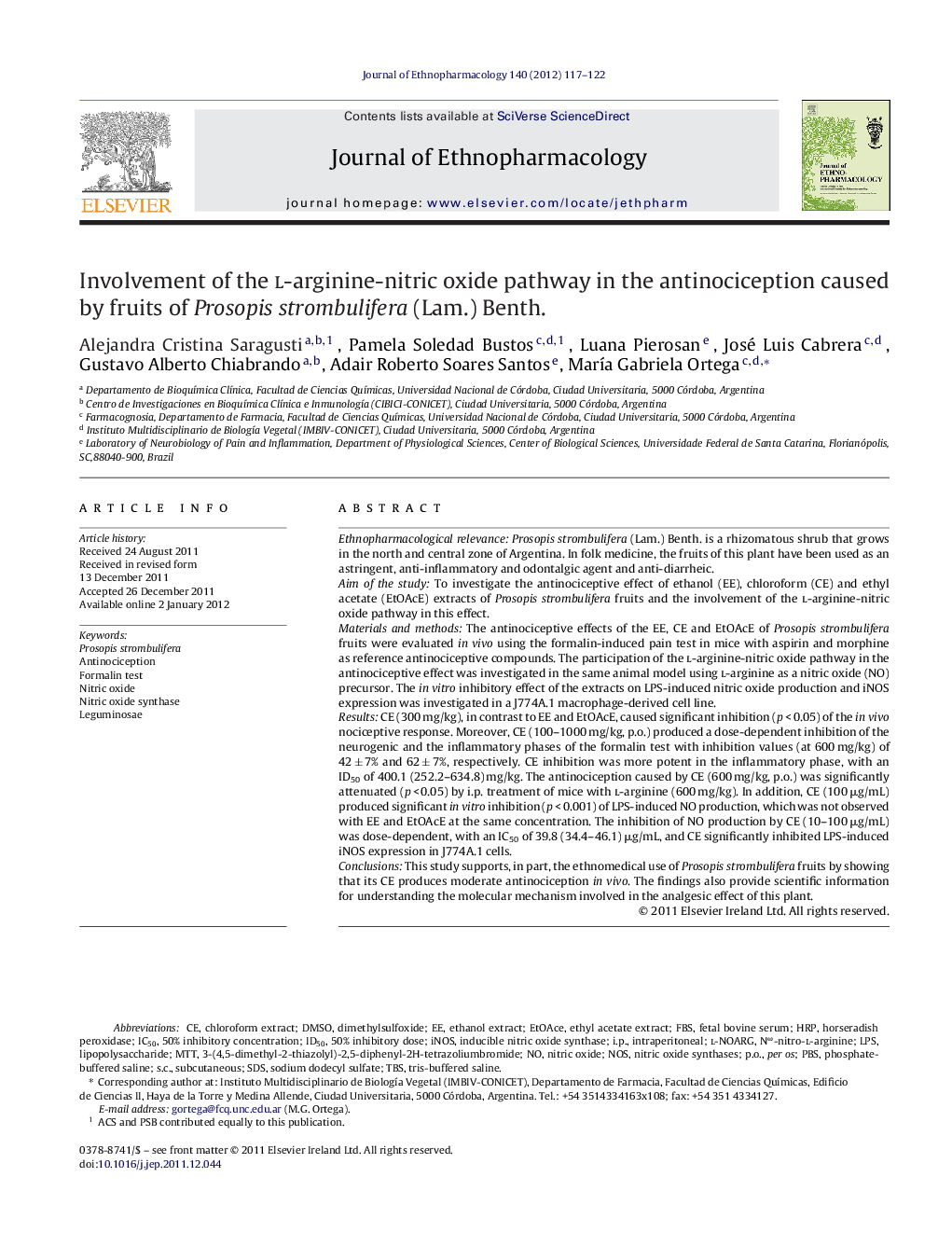| کد مقاله | کد نشریه | سال انتشار | مقاله انگلیسی | نسخه تمام متن |
|---|---|---|---|---|
| 5839278 | 1123991 | 2012 | 6 صفحه PDF | دانلود رایگان |
عنوان انگلیسی مقاله ISI
Involvement of the l-arginine-nitric oxide pathway in the antinociception caused by fruits of Prosopis strombulifera (Lam.) Benth.
دانلود مقاله + سفارش ترجمه
دانلود مقاله ISI انگلیسی
رایگان برای ایرانیان
کلمات کلیدی
LeguminosaeHRPTBSNOSIC50L-NOARGiNOSi.p.ID50FBSSDSLPSp.o.PBSs.c.50% inhibitory dose - 50٪ دوز مهاری50% inhibitory concentration - 50٪ غلظت مهاریDMSO - DMSOMTT - MTTNω-nitro-l-arginine - N-NITRO-L-ARGININEPer os - per osFormalin test - آزمون فرمالینTris-buffered saline - تریس بافر شورintraperitoneal - داخل صفاقیDimethylsulfoxide - دیمتیل سولفواکسیدsubcutaneous - زیر جلدیsodium dodecyl sulfate - سدیم دودسیل سولفاتfetal bovine serum - سرم جنین گاوinducible nitric oxide synthase - سنتاز اکسید نیتریک القاییNitric oxide synthases - سنتز اکسید نیتروژنAntinociception - ضد انعقادethanol extract - عصاره اتانولethyl acetate extract - عصاره اتیل استاتChloroform extract - عصاره کلروفرمlipopolysaccharide - لیپوپلی ساکاریدPhosphate-buffered saline - محلول نمک فسفات با خاصیت بافریNitric oxide - نیتریک اکسیدnitric oxide synthase - نیتریک اکسید سنتازHorseradish peroxidase - پراکسیداز هوررادیش
موضوعات مرتبط
علوم پزشکی و سلامت
داروسازی، سم شناسی و علوم دارویی
داروشناسی
پیش نمایش صفحه اول مقاله

چکیده انگلیسی
Ethnopharmacological relevanceProsopis strombulifera (Lam.) Benth. is a rhizomatous shrub that grows in the north and central zone of Argentina. In folk medicine, the fruits of this plant have been used as an astringent, anti-inflammatory and odontalgic agent and anti-diarrheic.Aim of the studyTo investigate the antinociceptive effect of ethanol (EE), chloroform (CE) and ethyl acetate (EtOAcE) extracts of Prosopis strombulifera fruits and the involvement of the l-arginine-nitric oxide pathway in this effect.Materials and methodsThe antinociceptive effects of the EE, CE and EtOAcE of Prosopis strombulifera fruits were evaluated in vivo using the formalin-induced pain test in mice with aspirin and morphine as reference antinociceptive compounds. The participation of the l-arginine-nitric oxide pathway in the antinociceptive effect was investigated in the same animal model using l-arginine as a nitric oxide (NO) precursor. The in vitro inhibitory effect of the extracts on LPS-induced nitric oxide production and iNOS expression was investigated in a J774A.1 macrophage-derived cell line.ResultsCE (300 mg/kg), in contrast to EE and EtOAcE, caused significant inhibition (p < 0.05) of the in vivo nociceptive response. Moreover, CE (100-1000 mg/kg, p.o.) produced a dose-dependent inhibition of the neurogenic and the inflammatory phases of the formalin test with inhibition values (at 600 mg/kg) of 42 ± 7% and 62 ± 7%, respectively. CE inhibition was more potent in the inflammatory phase, with an ID50 of 400.1 (252.2-634.8) mg/kg. The antinociception caused by CE (600 mg/kg, p.o.) was significantly attenuated (p < 0.05) by i.p. treatment of mice with l-arginine (600 mg/kg). In addition, CE (100 μg/mL) produced significant in vitro inhibition (p < 0.001) of LPS-induced NO production, which was not observed with EE and EtOAcE at the same concentration. The inhibition of NO production by CE (10-100 μg/mL) was dose-dependent, with an IC50 of 39.8 (34.4-46.1) μg/mL, and CE significantly inhibited LPS-induced iNOS expression in J774A.1 cells.ConclusionsThis study supports, in part, the ethnomedical use of Prosopis strombulifera fruits by showing that its CE produces moderate antinociception in vivo. The findings also provide scientific information for understanding the molecular mechanism involved in the analgesic effect of this plant.
ناشر
Database: Elsevier - ScienceDirect (ساینس دایرکت)
Journal: Journal of Ethnopharmacology - Volume 140, Issue 1, 6 March 2012, Pages 117-122
Journal: Journal of Ethnopharmacology - Volume 140, Issue 1, 6 March 2012, Pages 117-122
نویسندگان
Alejandra Cristina Saragusti, Pamela Soledad Bustos, Luana Pierosan, José Luis Cabrera, Gustavo Alberto Chiabrando, Adair Roberto Soares Santos, MarÃa Gabriela Ortega,